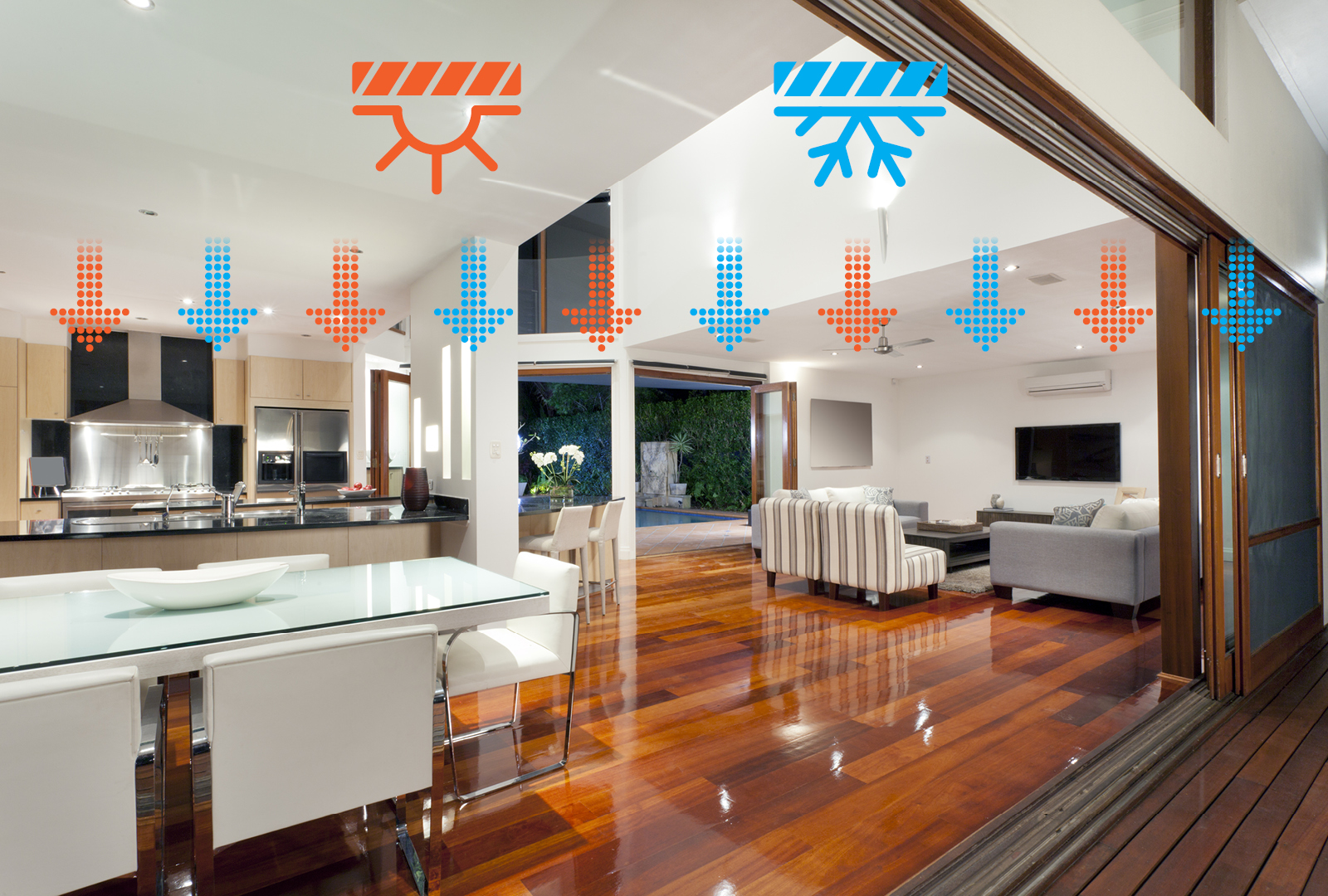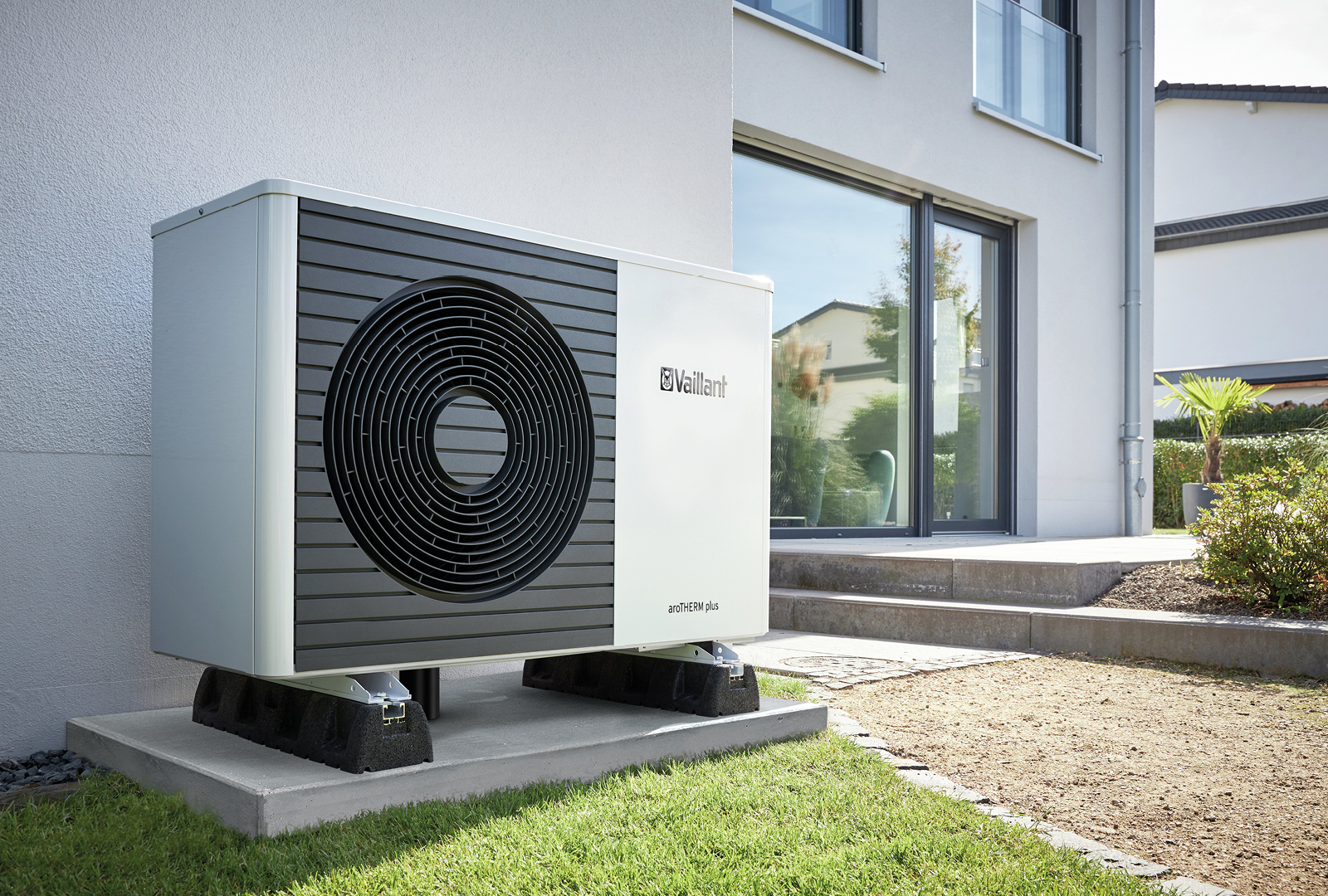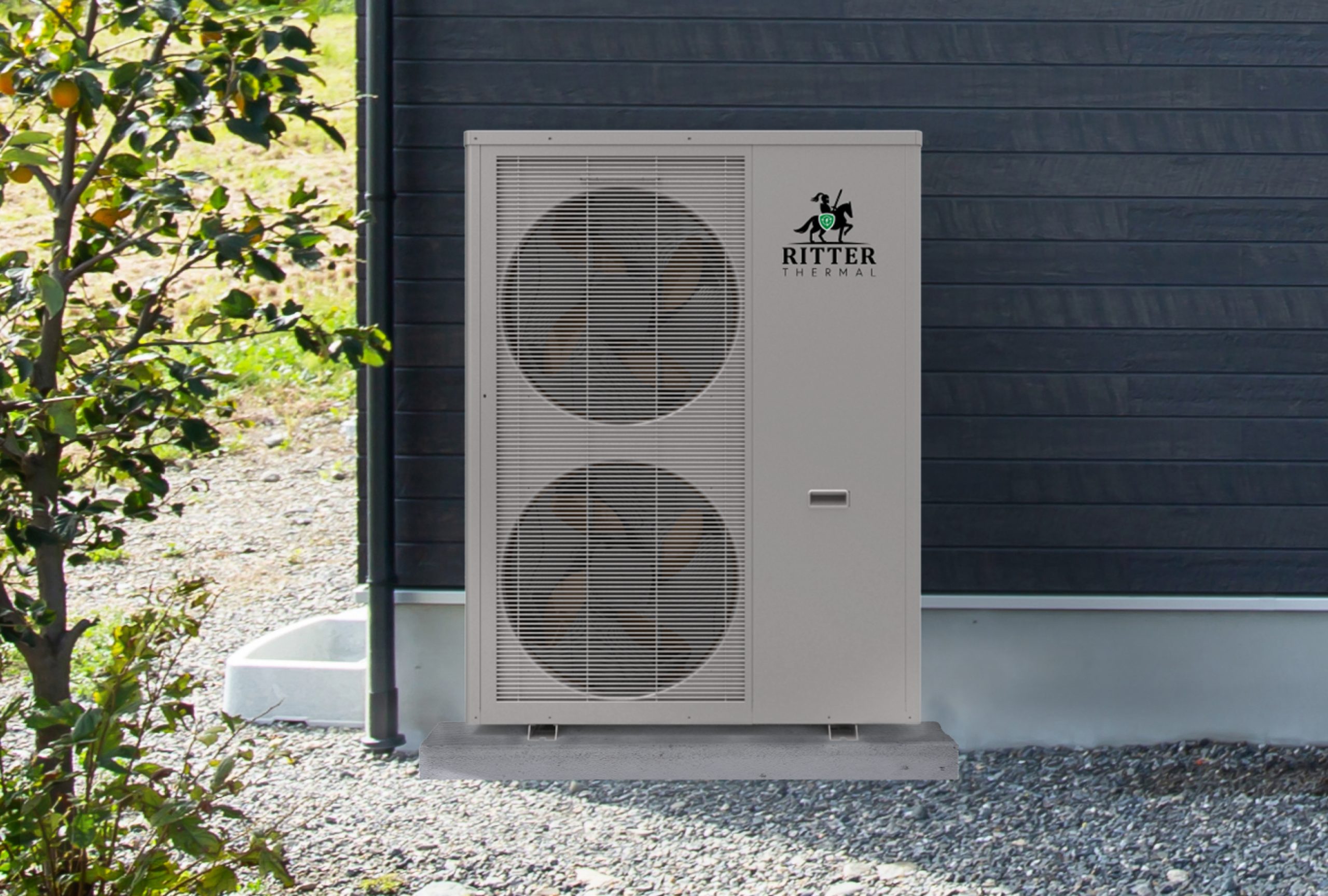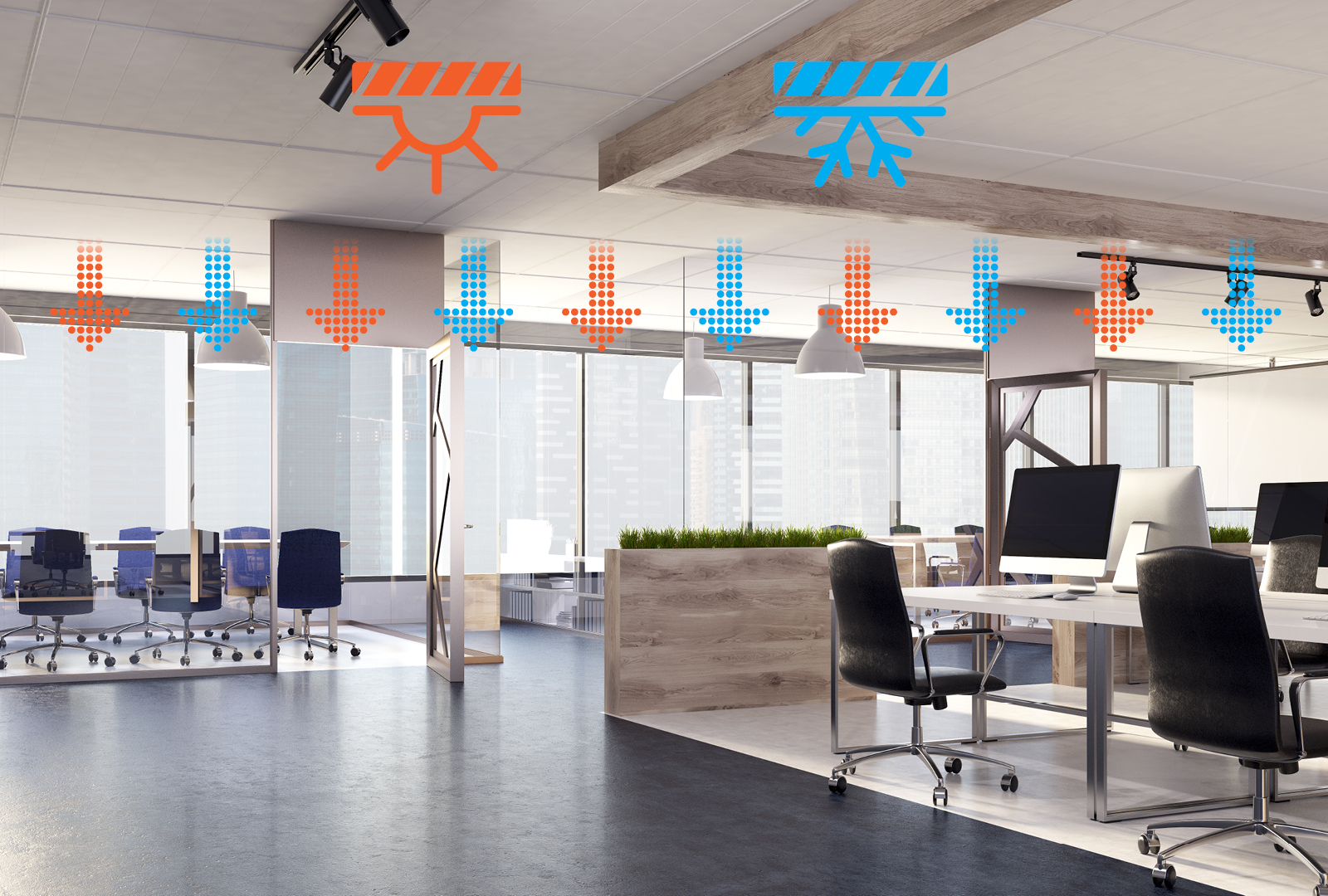Active Ceiling Heating & Cooling System

An Active Ceiling system provides the highest level of optimal comfort available on the market today. Heat your home throughout winter, and cool it down in the warmer months via one complete system.

As the system is totally concealed behind the ceiling drywall sheets, it is completely out of sight as it provides a uniform level of radiant heating and cooling to your home. With no air movement being generated, there is no recirculation or collection of dust, resulting in healthier and cleaner air. These systems are efficient, easy to control and quick to respond as there is no slab to heat or cool.

Active Ceiling systems powered by Vaillant aroTHERM air to water heat pumps harvest free energy found in the air outside the building envelope, and convert it into all season comfort and convenience.
Active Heating
In winter it circulates warm water throughout pipes within the ceiling panels and radiantly warms your entire home.
Active Cooling
In summer it reverses the process and circulates cool water to provide background cooling.
Domestic Hot Water
All year round it generates enough hot water to meet your entire household demand.
– Silent
– No air movement
– No dust circulation
– Capable of heating, cooling and domestic hot water
– Ultra energy efficient (up to 5:1) and compared to a gas-fired system saves the equivalent CO2 emissions reduced by a forest area of around 2,500m2

Messana Active Ceiling systems powered by Vaillant ecoTEC gas boilers are a good choice for all manner of heating and hot water loads particularly in areas with reticulated natural gas.
Active Heating
In winter it circulates warm water throughout pipes within the ceiling panels, which radiantly warms your entire home.
Domestic Hot Water
All year round it generates enough hot water to meet your entire household demand.
– Silent
– No air movement
– No dust circulation
– Capable of heating and domestic hot water
– ecoTEC are condensing boilers which utilize advanced combustion technology which scavenges energy found in the flue gas that would otherwise be lost to the atmosphere, resulting in running efficiencies up to 112%

Messana Active Ceiling systems powered by Grant Vortex diesel boilers are a practical option particularly in areas lacking reticulated gas.
Active Heating
In winter it circulates warm water throughout pipes within the ceiling panels, which radiantly warms your entire home.
Domestic Hot Water
All year round it generates enough hot water to meet your entire household demand.
The installation of a diesel boiler is typically more involved and costly than gas boilers but offer significant running cost savings over LPG options.
– Whisper quiet operation
– No air movement
– No dust circulation
– Capable of heating and domestic hot water
– Grant Vortex boilers have also adopted flue condensing technology resulting in running efficiencies up to 97%
– Advanced control panel enables sophisticated system control matching the capability found in the gas
and heat pump options

Heat your whole home efficiently with the Ritter Thermal Variable Speed Heat Pump. Unlike fixed speed motors. the variable speed motor adjusts to operate at the best speed to achieve your target temperature under different working conditions.
This improved operating efficiency means more comfortable living spaces and a lower energy bill. The hydronic RITTER THERMAL Variable Speed Heat Pump comes in two different capacities in order to supply your home with the optimum heating comfort.
In order to provide our customers with high quality, strong reliability and good versatility product, this heat pump is produced by strict design and manufacture standards.
Active Heating
In winter it circulates warm water throughout pipes within the ceiling panels, which radiantly warms your entire home.
Powered by electricity, the Ritter Thermal heat pump is using an entirely renewable energy which helps reduce the amount of harmful greenhouse gases being released into the atmosphere and in so doing, lowers the carbon footprint of the household.
– Silent
– No air movement
– No dust circulation
– Low noise level ensures quiet operation for the comfort of home owners and neighbours.
– A high level of performance even when its -10°C outside.
– Ultra energy efficient and compared to a gas-fired system saves the equivalent CO2 emissions reduced by a forest area of around 2,500m2.
Ritter Thermal heat pumps can deliver over four times the amount of energy for every single unit of electricity used depending on the flow temperature and the climate conditions prevailing at the time. Homes utilising this type of heat generator will obviously have a lower dependency on fossil fuels, making them less susceptible to rising fuel costs.

The Messana Active Ceiling grid system is a suspended ceiling system designed to regulate room temperatures using radiant heating and cooling technology. Powered by the Vaillant aroTHERM air to water heat pump which harvest free energy found in the air outside the building envelope, and converts it into all-season comfort and convenience.
Active Heating
In winter it circulates warm water throughout pipes within the ceiling panels and radiantly warms your entire area.
Active Cooling
In summer it reverses the process and circulates cool water to provide background cooling.
– Silent
– No air movement
– No dust circulation
– Capable of heating, cooling and domestic hot water
– Ultra energy efficient (up to 5:1) and compared to a gas-fired system saves the equivalent CO2 emissions reduced by a forest area of around 2,500m2

Download our brochure if you would like to understand more about our central heating and cooling solutions, estimated installation and running costs, or our design process.
Costs will vary depending on perceived comfort levels, insulation levels, ambient temperature extremes, building design/construction and regional energy prices. Below shows the estimated installation and running costs for a new 200m2 home based on 0ºC outside / 20ºC inside temperature.
| Appliance Type | System Type | Heating Only | Heating & Hot Water | Heating, Cooling & Hot Water | Winter Running Cost / Month | Calculation Parameters |
|---|---|---|---|---|---|---|
| Heatpump | Active Ceiling | $45,360* | $56,700** | $64,800** | $250 | 0.8c/kWh x 16hrs/day |
| Natural Gas Boiler | Active Ceiling | $34,020 | $39,960 | $190 | 0.07c/kWh x 6hrs/day | |
| LPG Boiler | Active Ceiling | $34,020 | $39,960 | $470 | 0.18c/kWh x 6hrs/day | |
| Diesel Boiler | Active Ceiling | $38,880 | $45,360 | $480 | 0.18c/kWh x 6hrs/day |
With the naked panel, the heating installer will hang and connect the panels.
The panels are hung between rondo placed at 600mm centers. Each side of the naked panel has an overhanging aluminum flap, which is tacked to the batten using a staple or similar. Connected runs of panels in larger areas are made by pushing two panels together after push fit connectors have been placed in one of the panels.
Each panel run (See panel installation guide) is connected to the manifold using insulated 16mm PEX (no aluminum barrier pipe can be used).
The panels are designed to be ceiling mounted and this is the recommended method, however, they can also be installed on walls which we would recommend being signed-off by a builder or architect.
The installation cost is generally less than an Underfloor system, however, the overall cost needs to be determined on a case by case basis. We are happy to quote both options.
The pipe can be easily repaired with pushfit coupling joints that do not require a tool.
The panels will experience minimal expansion and contraction with the heating and cooling of the system. The temperatures of the panels will typically reach around 40°C in heating mode, and 10°C in cooling mode which results in almost silent operation during the heating and cooling transitions.
The panels join using pushfit fittings specific to the radiant panels. The pushfit tees used are self-balancing to minimise flow rate balancing at the manifold.
As much as 70% coverage of the ceiling area is active panels, in high solar gain/high stud areas. Minimum of 50% coverage in low solar gain rooms with low cooling requirement and standard heating requirement. The panels are 2.4m x 0.6m and can be cut in half to form a 1.2m x 0.6m panel.
In heating mode, the flow temperature for heat pumps and boilers will be calculated by the Vaillant 700 controller. The flow temperature ranges from 25°C to 45°C, dependent on the outdoor temperature.
Using a Vaillant heat pump in cooling, the outdoor controller monitors the dew point and limits the flow temperature minimum to the calculated dew point value plus a safety factor (2°C as default). This could be as low as 10°C.
Due to the lower thermal mass of Active Ceiling systems, they are much more responsive than a floor based system and quickly reach operating temperatures.
In cooling mode we can deliver twice as much cooling power with an Active Ceiling system than we can with Underfloor systems.
The panels are suitable for ceiling battens at 600mm centres.
Penetrations up to 80mm between pipes, and 150mm in the centre of the panel diagonally between the ends of loops can be used for penetrations in active panels (see spec sheet for detailed diagrams). For penetrations larger than this, channels with no panels will need to be present.
Waterware will design and quote the system including the coverage area, the number of active panels required, and system layout plan.
The builder, electrician, and heating installer will usually work together to discuss and agree the final placement.
The naked panel is fitted behind the plasterboard, and so any finish or surface resistance can be achieved.
Where the panels definitely differ to slab Underfloor is their effectiveness.
- Quick heat up time due to large output per square meter and less thermal mass to overcome
- Not restricted by floor coverings or restricted in performance because of chosen floor coverings like carpet
- Significant cooling effect due to the increased cooling performance per square meter
- Less thermal mass so fantastic response to outdoor conditions
With a much lower thermal mass to overcome, the response time for the ceiling panels will be more similar to radiators.
The gypsum panel has an aluminum spreader plate, which encases the pipe and assists in conducting the heat from the pipes into the gypsum and keeps the whole panel at a consistent and even temperature.
The EPS foam layer on the gypsum panel has an R value of 1.
This is a common misconception.
Hot AIR rises but the ceiling panels operate by radiantly heating the room, similar to how the sun radiates heat to us on Earth.
Heat rising occurs mostly with methods of heating which use convection, such as air driven systems, where with radiant heating the building envelope as a whole is being warmed. Tests of installed product show the gradient of temperature change when the height varies is barely noticeable: 19.5°C at floor level, 20.5°C at 1.7m above floor level (radiant surface of ceiling @ 28°C).
Additional value gained from the panels over a slab Underfloor system:
- While a slab Underfloor provides a cooling effect, the radiant ceiling provides much more significant (up to two times per square meter) cooling performance
- Up to three times the heating output per square meter
- A faster responding radiant effect (in cooling and heating) to slab Underfloor
- Additional insulation to the ceiling, R=1
The heating system requires its yearly service like any other heating system where the heat source is checked and inhibitor re-added to the system. No panel specific maintenance costs.
Radiant panels are available ex-stock off the shelf but it is recommended to have the panels set aside during the planning process.







